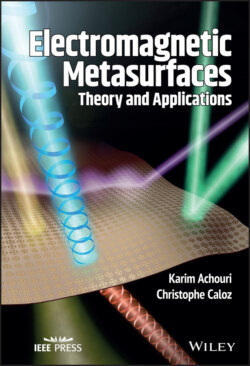Читать книгу Electromagnetic Metasurfaces - Christophe Caloz - Страница 19
2.5 Poynting Theorem
ОглавлениеThis section derives the time-average bianisotropic Poynting theorem [16, 81, 140], which provides the general conditions for gain and loss in terms of susceptibility tensors.
The time-domain Maxwell–Faraday and Maxwell–Ampère equations, assuming the presence of electric current sources, , and magnetic current sources, , are, respectively, given as
(2.53a)
(2.53b)
with the bianisotropic constitutive relations (2.4) defined by
(2.54a)
(2.54b)
Pre-multiplying (2.53a) by and (2.53b) by and subtracting the two resulting equations yields
(2.55)
The left-hand side of (2.55) may be simplified using the vectorial identity
(2.56)
where the cross product corresponds to the Poynting vector . This transforms (2.55) into
(2.57)
We shall now simplify the last two terms of this relation to provide the final form of the bianisotropic Poynting theorem. We show the derivations only for , but similar developments can be made for . From , we have that
(2.58)
Splitting the two terms of the right-hand side into two equal parts transforms this relation into
(2.59)
Manipulating the terms in the right-hand side of this new relation, adding the extra null term , and using the chain rule leads to
(2.60)
Grouping the first two, middle two, and last two terms of the right-hand side reformulates this relation as
(2.61)
which, using again , becomes
(2.62)
Finally, grouping the first two terms of the right-hand side of this relation yields
(2.63)
Similarly, the term in (2.57) becomes
(2.64)
Substituting now (2.63) and (2.64) into (2.57) finally yields the bianisotropic Poynting theorem:
(2.65)
where is the energy density, is the Poynting vector, and and are the impressed source power densities, and and are the induced polarization power densities, respectively, which are defined by
(2.66a)
(2.66b)
(2.66c)
(2.66d)
(2.66e)
It is generally more convenient to consider the time-average version of (2.65), which reads
(2.67)
where denotes the time-average operation. In the case of time-harmonic fields, this equation can be further manipulated as follows. First, it is straightforward to show that and . Second, the terms and may be expressed in terms of the electric and magnetic susceptibility tensors by using and , where the electric and magnetic conductivity tensors are related to the susceptibility tensors as
(2.68a)
(2.68b)
which leads, after replacing the instantaneous field vectors by their phaser counterparts, to
(2.69a)
(2.69b)
Third, we write the terms and in (2.67) in the frequency domain, which transforms the time-derivatives in 2.66d and 2.66e according to , so that
(2.70a)
(2.70b)
Substituting and in (2.70) by their constitutive definitions in (2.54) transforms (2.70) into
(2.71a)
(2.71b)
Finally, rearranging and simplifying the terms in (2.71) leads to
(2.72a)
(2.72b)
where the superscript corresponds to the transpose conjugate operation. The final expression of the time-average bianisotropic Poynting theorem for time-harmonic fields is then given by
(2.73)
where , and , are, respectively, provided by (2.69) and (2.72).
Integrating (2.73) over a volume defined by the surface , and applying the divergence theorem to the resulting left-hand side transforms this relation into
(2.74)
which indicates that the amount of loss or gain that an electromagnetic wave experiences in a given volume surrounding a medium is related to the amount of energy passing across the surface delimiting this volume.
If the medium is perfectly lossless and gainless, the amounts of electromagnetic energy entering and exiting the medium are equal, so that in (2.74), and therefore in (2.73). In the case of a lossy medium, there is less energy leaving than entering the volume, corresponding to , and vice versa for a gain medium, i.e. . Note that the fact that is a necessary but not sufficient condition for the medium to be gainless and lossless, since gain–loss compensation may occur between the terms on the right-hand side of (2.73).
Substituting (2.69) and (2.72) into (2.73) provides the following alternative form of the Poynting theorem:
(2.75)
In the absence of impressed surface currents, i.e. , then (2.75) reduces to
(2.76)
